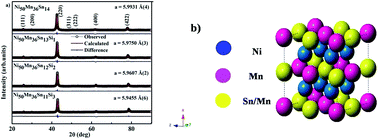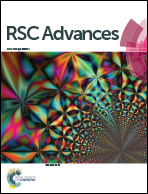Martensitic transition, spin glass behavior and enhanced exchange bias in Si substituted Ni50Mn36Sn14 Heusler alloys†
Abstract
The martensitic transition and exchange bias properties of the Heusler alloy system Ni50Mn36Sn14−xSix (x = 0, 1, 2 and 3) have been investigated. As the Si concentration increases, the martensitic transition temperature decreases while the Curie temperature of the austenite phases shows a slight increase. The temperature dependence of AC susceptibility with different frequencies at a low temperature regime was analyzed and the frequency dependence of the spin freezing temperature (Tf) showing a conventional critical slowing down relation confirms the spin glass behavior at low temperatures. Furthermore, the sample was recognized as a reentrant spin glass with both ferromagnetic and glassy states coexisting at least in the field cooled state. Due to these competing magnetic interactions, all the studied alloys exhibit exchange bias at low temperatures. For x = 2 alloy, an exchange bias field of 235 Oe is observed. However, on further increasing x, the exchange bias decreases. Therefore, it is quite evident that the unidirectional anisotropy decreases as a function of Si concentration. The double shifted hysteresis loop after zero field cooling and training effect strongly support the presence of exchange bias in these alloys. The dependencies of EB on various parameters like temperature and cooling field have also been investigated.


 Please wait while we load your content...
Please wait while we load your content...